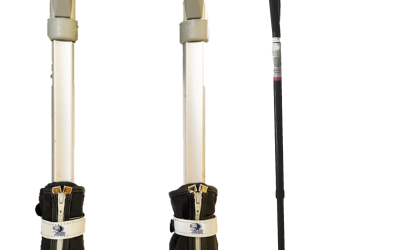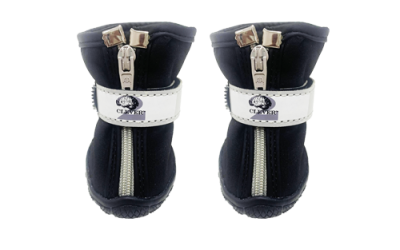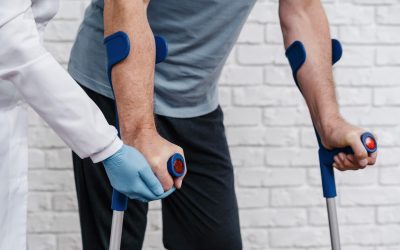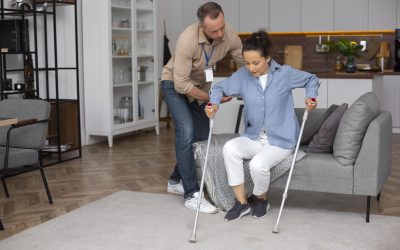Mastering Mobility: A Comprehensive Guide on How to Use Crutches Correctly”
How to use crutches correctly takes practice. Crutches are invaluable tools that provide mobility and support to individuals recovering from injuries, surgeries, or dealing with temporary conditions affecting their ability to walk. However, using crutches correctly is crucial to ensure both safety and efficiency. In this comprehensive guide, we will delve into the proper techniques and tips on how to use crutches correctly, empowering individuals to navigate their daily lives with confidence and comfort.
How to use crutches correctly starts by using the SafeNDry Crutch Boots for Winter-Wet Conditions.
As winter approaches, consider equipping yourself or your loved ones with SafeNDry Crutch Boots to ensure a secure and hassle-free winter season. Say goodbye to the worries of slips, falls, and cumbersome drying processes, and embrace the freedom and safety that SafeNDry Crutch Boots provide.
Upgrade your winter mobility and safety with SafeNDry Crutch Boots – the ultimate solution for a dry and secure crutch-cane experience in challenging weather conditions!
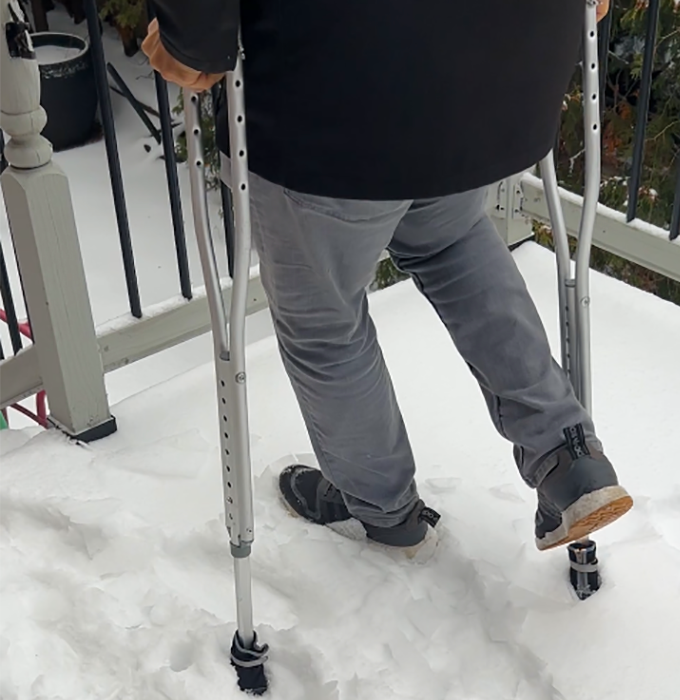
Watch The SafeNDry Crutch Boots Features And Benefits Video, by: 2Clever
1. Selecting the Right Crutches
Choosing the right type of crutches is the first step in ensuring proper usage. There are several types available, including underarm crutches, forearm crutches, and platform crutches. The selection depends on factors such as the user’s strength, balance, and the nature of their injury or condition.
2. How To Use Crutches Correctly – Adjusting Crutches to the Correct Height
Proper height adjustment is essential for effective use of crutches. Follow these steps to adjust the crutches to the correct height:
- Stand upright with shoes on.
- Place the crutches about 6 inches to the side and 6 inches in front of your feet.
- Adjust the handgrips to align with the crease of your wrist when your arms are hanging down.
The correct height ensures that your weight is distributed evenly, preventing discomfort or strain.
3. Correct Arm Placement on Underarm Crutches
For underarm crutches, arm placement is critical for both comfort and support. Follow these steps:
- Stand up straight with the crutches by your sides.
- The top of the crutch pads should be about 1-2 inches below your armpits.
- Elbows should be slightly bent when holding the handgrips.
Avoid putting excessive weight on your underarms to prevent nerve damage or discomfort.
4. Correct Hand Placement on Forearm Crutches
For forearm crutches, proper hand placement is essential for stability and control. Follow these steps:
- The handgrips should be adjusted so that your wrists are level with the top of the crutch.
- Hold the handgrips with a firm but relaxed grip.
- Elbows should be slightly bent when walking.
How to use crutches correctly explained: Proper hand placement ensures efficient use of forearm crutches while minimizing strain on the wrists and arms.
5. Learning the Correct Walking Technique
Mastering the correct walking technique is crucial for stability and balance. Follow these steps:
- Advance both crutches forward together, placing them about a step’s length in front of you.
- Step forward with the injured or weaker leg, placing it between the crutches.
- Shift your weight onto the crutches, taking the weight off the injured leg.
- Finish the step by bringing the stronger leg forward.
Practice this walking pattern in a controlled environment before attempting more challenging terrain.
6. Navigating Stairs Safely with Crutches
Climbing stairs with crutches requires careful coordination. Follow these steps:
- Ascending: “Up with the good, down with the bad.” Start with the good (uninjured) foot when going up stairs. Push down on the crutch handles for support as you step up.
- Descending: “Down with the bad, up with the good.” Start with the injured foot when going down stairs. Lower the injured foot to the step below, followed by the crutches.
Take one step at a time and ask for assistance if needed, especially when dealing with a more challenging staircase.
7. Sitting and Standing Safely with Crutches
Proper technique for sitting and standing ensures a smooth transition between different positions. Follow these steps:
- Sitting: Back up until you feel the back of your legs against the chair. Reach back with one hand for the armrest, using the other hand on the crutch for support. Lower yourself slowly into the chair.
- Standing: Use the crutches for support and push up from the chair. Once standing, ensure your balance before taking a step.
Maintain a controlled and deliberate movement to prevent accidents during these transitions.
8. Negotiating Uneven Terrain and Obstacles
Walking with crutches on uneven terrain or navigating obstacles requires additional attention. Tips for negotiating such situations include:
- Take small steps and concentrate on maintaining balance.
- Approach curbs or obstacles at a right angle to minimize the risk of tripping.
- Use caution on slippery surfaces, and consider additional accessories like crutch tips designed for winter conditions.
9. Keeping Crutches in Good Condition
Proper maintenance ensures that crutches remain safe and functional. Regularly inspect your crutches for:
- Loose screws or bolts.
- Cracked or damaged crutch tips.
- Any signs of wear on handgrips or padding.
Address any issues promptly to avoid compromising the effectiveness of your crutches.
10. Seeking Professional Guidance
When in doubt or facing challenges in using crutches, seek guidance from a healthcare professional or physical therapist. They can provide personalized advice, adjustments, and exercises to improve your mobility and ensure correct crutch usage.
Conclusion
Mastering the correct use of crutches is an empowering journey that enhances mobility and facilitates the healing process. By selecting the right type of crutches, adjusting them to the correct height, and practicing proper techniques for walking, stairs, sitting, and standing, individuals can navigate their daily lives with confidence.
How to use crutches correctly. Remember, patience and practice are key components of adapting to crutch use. Seeking guidance from healthcare professionals ensures that you receive personalized advice tailored to your specific needs and condition. With the right knowledge and techniques, using crutches correctly becomes not just a necessity but a skill that promotes safety, comfort, and a smoother road to recovery.
